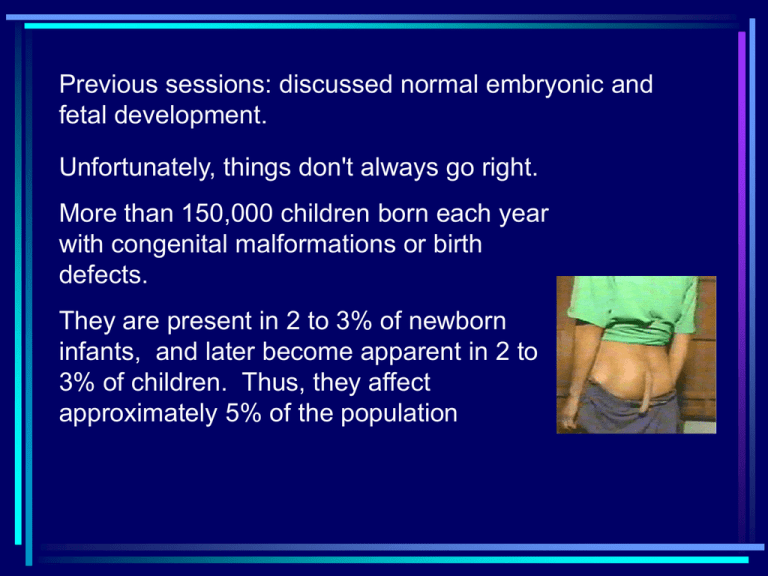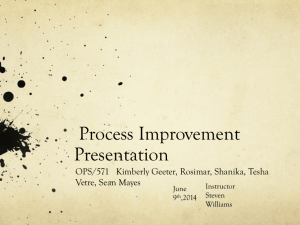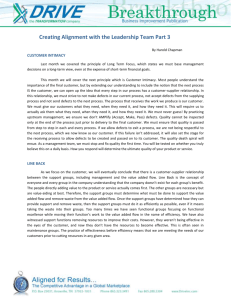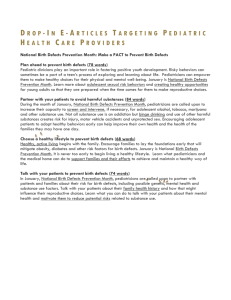HUMAN REPRODUCTION BIOLOGY 269
advertisement

Previous sessions: discussed normal embryonic and fetal development. Unfortunately, things don't always go right. More than 150,000 children born each year with congenital malformations or birth defects. They are present in 2 to 3% of newborn infants, and later become apparent in 2 to 3% of children. Thus, they affect approximately 5% of the population More than 4,000 different forms of birth defects known Can affect any organ and Often affect multiple organs Range: mild Syndactyly moderate Encephalocele severe Syncephalus/Janiceps From: March of Dimes Defects of heart and blood vessels: Aortic coarctation Cerebral aneurysm Patent ductus arteriosus Tetrology of Fallot Valve stenosis Defects of urinary system/genitalia Extrophy of bladder Hypospadias Wilm’s tumor or Nephroblastoma Stenosis of ureter Defects of face: Goldenhar Syndrome Cleft lip & palate Occulofacial dysplasia Hirsuitism Defects of brain and/or spinal cord: Spina bifida Anencephaly Rachischisis Hydrocephalus Defects of limbs: Meromelia Bifurcation of hand Supernumary arm Syndactyly Polydactyly The earlier in development that problems develop, the more severe the birth defects will be Many possible causes: Chromosomal/genetic abnormalities Drugs taken by mother which cross placenta Infections of mother which cross placenta Antibodies produced by mother Environmental agents Injury to fetus or during birth However, cause is unknown ~ half the time Chromosomal abnormalities: Either: Wrong number of chromosomes One or more abnormal chromosomes Since all cells of all organs have same chromosomes, chromosomal abnormalities often affect many different organs Chromosomal abnormalities: Trisomy 21, or Down's Syndrome ~ 1 out of 660 live births Abnormalities of face, Abnormalities of hands, feet Heart defects Deafness Usually marked cognitive and intellectual impairment Chromosomal abnormalities: Trisomy 18, or Edward's Syndrome ~ 1 out of 3,000 live births Most fetuses die in utero; Half of live births die < 2 weeks Survival > 20 years rare Abnormal face, Abnormal hands, feet Heart defects Kidney defects Marked cognitive and intellectual impairment Chromosomal abnormalities: Trisomy 13, or Patau Syndrome ~ 1 out of 10,000 live births Most fetuses die in utero; 80% of live births die in first year Survival > 20 years very rare Abnormal head and face, particularly eyes and palate Abnormal hands, feet Heart defects Kidney defects Very severe cognitive and intellectual impairment Chromosomal abnormalities: Turner's syndrome: X~ 1 out of 1500 live female births Short female; Poorly developed sexual characteristics Never enters puberty therefore sterile. Defects in heart, lungs, vessels, bones Occasionally cognitive and intellectual impairment Chromosomal abnormalities: Abnormality (missing piece) of chromosome #5 Cri du chat syndrome Abnormal cry Small head & face Eye abnormalities Damage to brain Marked cognitive and intellectual impairment Chromosomal abnormalities: Mutation on chromosome #4 Achondroplasia Lack of bone growth, primarily affecting limbs, skull, and vertebrae Muscular weakness Usually no abnormalities of other organs No cognitive or intellectual impairment Chromosomal abnormalities: Mutation on X chromosome Duchenne Muscular Dystrophy Abnormal growth in all muscles leading to severe weakness Usually no abnormalities of other organs No cognitive or intellectual impairment Respiratory failure often leads to death in early adult years Drugs taken by mother; Cross placenta to embryo Hundreds of drugs known to cause birth defects. Potential for birth defects = most common reason drugs restricted Best known = Thalidomide (sedative): Limb abnormalities Absent (whole or part), Short, Malformed Defects in heart, lungs, digestive system Similar abnormalities occurred in children whose mothers took the acne drug Accutane (isotretinoin) during pregnancy. Examples of other drugs linked to birth defects: Aminopterin or Methotrexate (antitumor agents) Defects of brain, nerves, skeleton (often limbs) eyes, heart Diethylstilbesterol ( ↓ miscarriage) Defects of uterus, vagina Vitamin A Defects of brain, spinal cord, face (cleft palate/lip), heart Streptomycin (antibiotic) Deafness from damage to inner ear Diseases and infections of mother may cause birth defects, including many diseases which are relatively mild to her Bacteria, viruses, etc. may cross placenta to embryo or Antibodies produced by mother's immune system may cross placenta and damage embryo Some common diseases linked to birth defects Cytomegalovirus: Defects of head & face, brain, eyes, other organs Rubella: Defects of eyes, brain, heart; Deafness Herpes simplex virus: Defects of eyes, head, brain Examples of chemicals in food, air, water linked to birth defects when they cross the placenta to the embryo Mercury: Abnormalities of brain, nerves, heart Abnormalities of skeleton (often limbs) Blindness, deafness. spasticity Intellectual impairment Lead: Abnormalities of brain, bone Blindness, deafness Intellectual impairment Ethanol: Decreased fetal growth Abnormalities of face (cleft palate/lip) Emotional & learning problems Physical trauma to fetus can cause birth defects: Increased uterine pressure can cause dislocated hip, shoulder, deformed limbs, deformed skull Constriction by umbilical cord can cause amputation of limbs Damage to the brain before or during birth can lead to cerebral palsy Again: Cause of birth defects is unknown more than half the time






